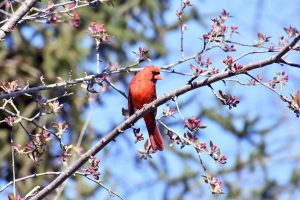Adventuring While Birding: Safety Tips for Backcountry Travels
 Photo by Michelle Walcott on Unsplash
Photo by Michelle Walcott on Unsplash
By Avery Phillips
Sometimes a birding adventure takes you off the beaten path and beyond cell service, away from the neverending stresses and notifications of home and work. While rugged ventures on the edge of civilization can be refreshing and rewarding, they also leave you isolated and far from help should trouble arise. But fear not! We have a few tips to ensure a safe and fun birding adventure.
Adventure Safely
While birdwatching is generally a safe activity, there are still a few precautions to keep in mind—especially if you’re going off the grid. First, try to bring a friend whenever you head out on a birding adventure. Not only does a friend provide companionship and an extra pair of bird-watching eyes, but they’ll also watch your back and keep you from getting lost if you’re a wanderer.
If you insist on traveling alone, be sure to let somebody know your planned route and tell them where you’ll be and when you’ll be home. Likewise, it’s not a bad idea to pack a whistle with you, just in case.
Second, beware of trespassing on private land; look out for signs near trailhead entrances. It’s easy to get consumed by the hunt for exotic wildlife, but people can be protective of their property if you wander from public to private lands.
Finally, be watchful of other types of wildlife. Protect yourself against ticks and mosquitos with long clothes, nets, and bug spray. Also be aware of larger predators like bears, mountain lions, wolves, and moose—any one of these animals will attack if humans approach them. Depending on the animals residing in the area you plan to explore, you might need to bring bear spray or learn other ways of protecting yourself in the wild. If you do encounter a large mammal, slowly back away and try to refrain from running or making any sudden moves.
Bring Food and Water
No matter how long you plan to trek into the wilderness, packing some food and water (or a water filtration system) is essential. You will need some nourishment to fuel you through the day, but prepare for the worst (i.e., if you get lost and need to sustain yourself for a little longer than expected). When you’re out hiking and birding, bring some low-glycemic foods along with you. Foods with a low glycemic index are best because they’ll keep your blood sugar from spiking right after you eat the food and then drastically dropping, causing fatigue and hunger. Try a few of these options on your next hike:
- Berries
- Crackers
- Dried fruit
- Granola bar (protein bar, energy bar, etc.)
- Jerky
- Trail mix
With these snacks in tow, you’ll never have to leave a choice birding spot just because you’re hungry.
Use Technology to Your Advantage
Taking breaks from technology is great for your health because it gives you the mental space to relax without constant notifications and incoming messages. Birding is a great way to get into the woods and away from technology, but that doesn’t mean you shouldn’t use some helpful tools to your advantage! However, when you’re traveling off-grid, and you don’t have any cell service or Internet connection, how do you take advantage of the birding apps and tools you love to use? Apps like the eBird mobile app can offer offline checklists, and BirdsEye’s new offline capabilities will help you discover the birds you are likely to find around you. You’ll want to make sure and track your GPS location manually when you’re out of cell service range.
When heading out for the day, make sure to fully charge your device, even if you don’t intend to use them. Just in case you need to make an emergency call, you’ll need a fully charged phone handy.
* * *
If birding is your hobby, then you probably spend plenty of time in the wilderness without a cell tower in sight. Birding is a great way to spend your free time, but make sure you take the necessary precautions to ensure a safe and fun trip!
